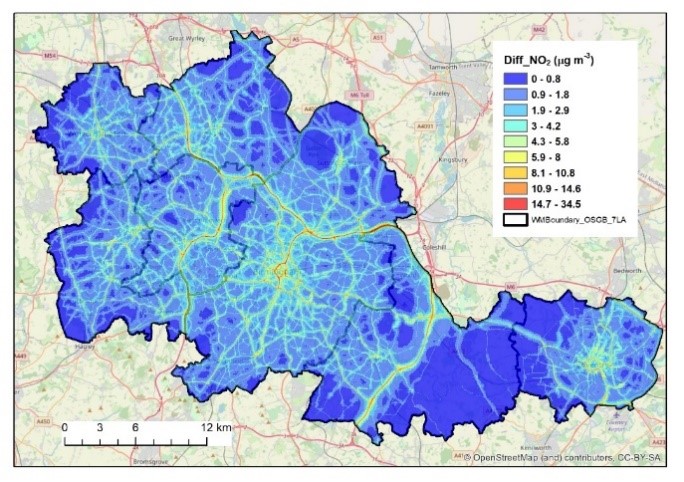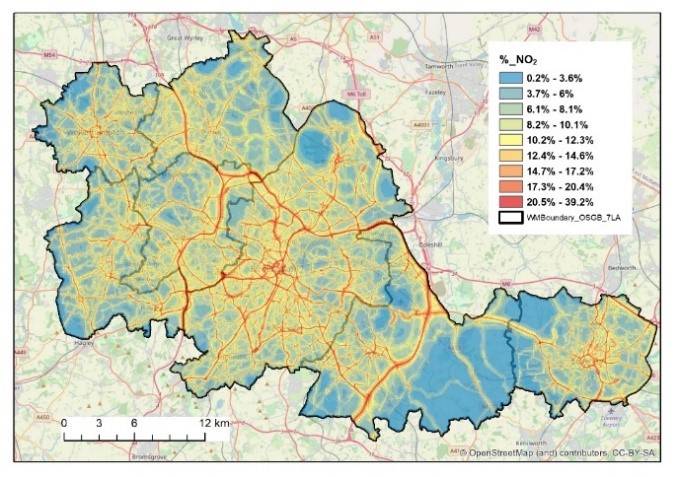by William Bloss, Joe Acton and Jian Zhong
“Clean Air”, measures to reduce carbon emissions, clean air zones, electric vehicles, net zero, global warming – this now-familiar terminology is often conflated in public understanding and sometimes mixed up in policy ambitions, obscuring valuable co-benefits from what should be complementary strategies.
This is not just semantics: there are many policy win-wins between climate and air pollution measures, but also some tensions – and these benefits and tensions arise differently geographically, and hence, electorally. For many air pollutants, changes in local behaviour deliver local air quality improvements and hence improve the health of the local population – while tackling the climate challenge requires reductions in the growth of global carbon dioxide concentrations.
Recent polling by Climate Outreach revealed that 87% of people were very or somewhat worried about climate change, with 50 - 94% of respondents accepting that climate change was “real and caused by human action”. However, significant proportions (up to 40%) felt that we should “focus on protecting the environment at home”, rather than global engagement. Importantly, there is a strong correlation between the groups which are least engaged with the climate challenge, and those who support a local focus for environmental improvement.
Being clear over the distinctions and complementarities between climate change and air pollution allows us to prioritise the biggest policy wins overall, and can make behaviour change more relevant to the communities involved and impacted, increasing their agency and engagement. Here we unpick the distinction between climate and air pollution, and their contrasting geographies of effect. We illustrate the scope for regional policy win-wins focussing upon transport measures in the West Midlands.
Climate change: mostly global
Climate change – the increase in global mean temperatures, changes in weather patterns, and ocean acidification – is primarily driven by increasing concentrations of long-lived greenhouse gases, of which carbon dioxide (CO2) is the most important. “Long lived” here means that carbon dioxide lasts for many years in the atmosphere (more precisely, whilst the carbon is cycling between the atmosphere, oceans and biosphere). Carbon dioxide mixes around the planet through the atmosphere, and carbon dioxide levels in the air above Birmingham are similar to those above Beijing and above Bermuda – the atmospheric levels reflect integrated global emissions.
Climate policy related to carbon dioxide is a global challenge, requiring international approaches such as the Paris Agreement and COP26. The environmental science reality is that individual countries or cities cannot control the CO2 levels in their atmospheres – or the climate change they will experience – through national actions alone.
This framing of the climate challenge as a tragedy-of-the-commons issue, with narratives of intergenerational and geopolitical inequity tensioned against (near-term) economic cost has hindered progress and public (and hence political) palatability of action. Why should I change my lifestyle to reduce emissions, at cost to me, when my geopolitical neighbour isn’t doing the same?
This narrative can change when we consider air pollutants species which are present in the air at levels harmful to human or environmental health (carbon dioxide is not directly harmful to health at the levels usually encountered in outside air).
The Air We Breathe
In urban environments, the key air pollutants driving health impacts are fine particles suspended in air, and nitrogen dioxide gas (NO2). Airborne particles include PM2.5 – the fraction of particulate matter (PM) less than 2.5 micrometres in diameter, around 1/50th the width of a human hair, small enough to be inhaled into our lungs. In the UK, the combined effects of long-term exposure to nitrogen dioxide and PM cause 24-36,000 excess deaths each year, and air pollution was recently identified as a material cause of death for the first time in a Coroner’s Report, in the case of 9-year-old Ella Adoo-Kissi-Debra.
The dominant source of nitrogen dioxide in urban environments is local road traffic exhaust emissions – especially from older and diesel vehicles – with smaller contributions from industry, power generation and other activities. The main PM emission sources are combustion – domestic solid fuel combustion, industrial combustion, road transport (exhaust and non-exhaust) and industrial processes, alongside agriculture and natural components. A significant proportion of PM is formed in the atmosphere from gases, which, in turn, derive largely from road transport, power generation and industrial combustion.
There is therefore very strong overlap between many of the sources of air pollution (i.e. combustion) and of anthropogenic carbon emissions (i.e. fossil fuel combustion).
Air Pollution: All Politics is Local
However, the geography of air pollution differs: atmospheric chemistry removes nitrogen dioxide from the air, on a timescale of 12-24 hours. If we reduce traffic emissions in a given city, nitrogen dioxide levels in that city will fall, and health benefits to the local population will result. To use the example above, Birmingham can improve its air quality without needing action in Beijing, or in Bermuda. Airborne particles last a little longer – they are removed by processes like rainfall and deposition to surfaces, and persist for a few days in the lower atmosphere – so a regional-to-national approach is needed.
This means that local, regional and national action to tackle many key carbon emissions – e.g. fossil fuel combustion for heating, industry, power and transport – also address many of the dominant local and regional air pollution sources. As the air pollutants have much shorter lifetimes, local changes leading to reductions in their local emissions give rise to lower local concentrations and improved health outcomes for the local population – a subtly different proposition to encourage action.
Transparent communication of the air quality benefits from climate / net zero measures can increase the support for difficult policy choices, and more accurately account for the secondary benefits that many such measures have. While formal methods exist to account for the air quality co-benefits of carbon emissions reductions, there is limited wider appreciation of the distinction between the climate and air pollution geographies. Indeed, images of cooling towers (releasing water vapour, i.e. harmless clouds) are recurrent in news stories regarding air pollution – and the local/regional nature of the air pollution footprint is often neglected.
Assessing the benefit
Surveys have found that air pollution concerns resonate, and images of air pollution have been found to be the most effective in visually communicating the health impacts of climate change; – 75 % of respondents say that air pollution was the climate impact they felt they could do most about personally – compared to, for example, 6 % in the case of floods. However, quantifying the air quality / climate interactions can be challenging.
In the West Midlands, the University of Birmingham’s WM-Air project[1] has been working with the West Midlands Combined Authority (WMCA) to quantify and illustrate the air-quality co-benefits of net zero policy options, aligned with the WMCA’s commitment to achieve net zero by 2041. A key aspect of regional decarbonisation is transport strategy, including bus, car and light vehicle electrification – as transport accounts for 36% of West Midlands carbon emissions. In parallel, many areas in the region experience elevated nitrogen dioxide concentrations (leading to significant health and economic impacts, outlined in a recent CBI report, and driving policy responses such as the Birmingham Clean Air Zone).
Here we show the air quality co-benefit for an achievable vehicle electrification scenario, focussing on service vehicles. If the region’s buses were electrified, and 50 % of light delivery vehicles converted to electric, the WM-Air air quality model predicts reductions in annual mean nitrogen dioxide concentrations of 15 – 35 µg m-3, or 20-35 %, could be achieved. These results probably underestimate the air quality benefits, as the light delivery fleet has expanded significantly with final-mile-delivery of online shopping during Covid.


Impact of bus electrification + 50% light vehicle electrification (total traffic levels unchanged) on annual mean nitrogen dioxide concentrations across the West Midlands. Left panel: Reduction in annual mean nitrogen dioxide; Right panel: percentage change vs Business-as-Usual scenario. We assume no impact of the power generation source, i.e. remote or renewable electricity generation.
A More Complex Picture
We have highlighted one aspect of the air quality-climate interchange, emphasising the local pay-off in terms of air pollution and health from actions which effectively tackle the climate challenge. There are many more nuances to this story – some of which represent policy tensions rather than win-wins (for example, diesel vehicles typically have lower carbon emissions than their gasoline equivalents, but higher air pollution emissions) and which are detailed elsewhere.
Further exploration of scenarios such as that shown above can unpick issues of environmental equity and justice. In the example above, focussing on bus route electrification tends to concentrate the air pollution reduction benefits to areas of the highest population density; prioritising light delivery vehicles achieves an even greater reduction in exposure – but lower gains for the most polluted locations which tend to correlate with the most disadvantaged communities. The air pollution co-benefit from climate policy can then become a measure of policy prioritisation, a tool for local environmental improvement, and a mechanism addressing local environmental health inequalities.
[1] WM-Air is a five-year project programme of activities to apply the latest research science to deliver regional impact - in societal, economic and policy terms - in support of improved air quality and health across the West Midlands. WM-Air is led by the University of Birmingham, funded by the UK Natural Environment Research Council, and delivered through a portfolio of projects with external partners.
Financial support from NERC (NE/S003487/1) and the University of Birmingham Institute for Global Innovation.